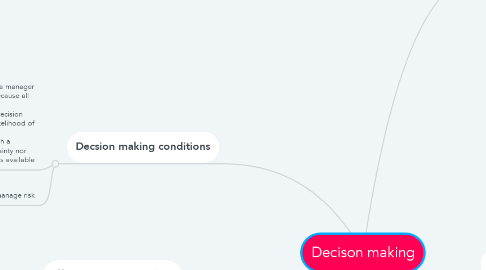
1. Decsion making conditions
1.1. - Certainty: a situation in which a manager can make accurate decisions because all outcomes are known - Risk: a situation in which the decision maker is able to estimate the likelihood of certain outcomes - Uncertainty: a situation in which a decision maker has neither certainty nor reasonable probability estimates available
1.2. How to manage risk
1.2.1. Expected Value. see 2.8
1.2.2. Heuristics
2. Effective decsion making techniques
2.1. - Understand cultural differences - Create standards for good decision making - Know when it’s time to call it quits - Use an effective decision-making process - Develop your ability to think clearly
3. Types of decisions. See 2.7
3.1. Structured Problems
3.1.1. Straightforward, familiar, and easily defined problems
3.1.2. Programmed Decisions
3.1.2.1. Repetitive decisions that can be handled by a routine approach
3.1.2.1.1. - Procedure: a series of sequential steps used to respond to a well-structured problem - Rule : an explicit statement that tells managers what can or cannot be done (lateness and absenteeism ) - Policy: a guideline for making decisions. Policies typically contain an ambiguous term that leaves interpretation up to the decision maker
3.2. Unstructured problems
3.2.1. Problems that are new or unusual and for which information is ambiguous or incomplete
3.2.2. Nonprogrammed Decisions
3.2.2.1. Unique and nonrecurring and involve custom made solutions
4. Characteristics of an Effective Decision-Making Process
4.1. - Focuses on what’s important Is logical and consistent - Acknowledges subjective and analytical thinking, blends analytical with intuitive thinking - Requires only as much information as is needed to resolve particular dilemma - Encourages the gathering of relevant information - Is straightforward, reliable, easy-to-use, flexible
5. Decision making steps
5.1. Identify a Problem
5.2. Identify decision criteria
5.3. Weights to criteria
5.4. Develop alternatives
5.5. Analyze alternatives
5.6. Select alternative
5.7. Implement alternative
5.8. Evaluate decision
6. How do managers make decisons
6.1. Rationality
6.1.1. - Logical and objective - Problem clear and unambiguous - Clear, specific goal & aware of all alternatives and consequences - The alternative that maximizes achieving this goal will be selected - Decisions are made in the best interest of the organization
6.2. Bounded Rationality
6.2.1. - Bounded rationality: decision making that’s rational, but limited by an individual’s ability to process information - Satisfice: accepting solutions that are “good enough” - Escalation of commitment: an increased commitment to a previous decision despite evidence it may have been wrong
6.3. Intuition
6.3.1. A subconscious process of making decisions based on experience & accumulated judgment
6.3.1.1. See chart 2.6
6.4. Evidence-based management
6.4.1. systematic use of the best available evidence to improve management practice.
6.4.1.1. Four essential elements of EBMgt: - The decision maker’s expertise and judgment; - External evidence that’s been evaluated by the decision maker; - Opinions, preferences, and values of those who have a stake in the decision; - Relevant organizational (internal) factors such as context, circumstances, and organizational members.
